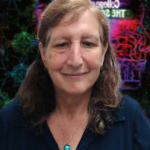Throughout my career as an educator, a statistic I’d seen continued to stick in my head: 80% of people living with disabilities between the ages of 24 and 64 are unemployed. Especially considering the lack of support in public education for students with disabilities, I knew I wanted to do something to make a difference — which is why, in 2014, I started Catalyst at North Carolina State University, which creates opportunities in STEM for students with disabilities.

Today, Catalyst is a program within the university that aims to open opportunities in science, technology, engineering and math to high-school students with disabilities. We now have a class of 40 students with various forms and types of disabilities, from muscular dystrophy to dyslexia. And we are working hard every day to ensure those students do not fall into this 80% statistic and history of unemployment, but rather get to explore hands-on research and even participate in internships.
The pathway to this level of success and support for the disabled community did not occur overnight. It took my experience and expertise to put together this program and the curriculum. But investing time and resources into this important work is critical to creating opportunities for those who face disproportionate impacts of unemployment. So how can we do better? I’ll take us back to the beginning of the journey.
Issues facing STEM education in public schools
I taught grades pre-K-12 as a special education and science teacher in Wake County Public Schools for 20 years, and my students were 98% from communities with low incomes and people of color. From this experience, I saw first-hand the benefits of high-quality STEM and tech education — and I learned how it helps students with disabilities transcend education inequity by training for high-demand careers so they can succeed in a competitive workforce.
But in the public school system, I struggled to bring my vision to life.
Perhaps the most critical element I discovered during my two-decade-long tenure with public schools is that hands-on learning is the best way to teach STEM. However, at the time, I was only given a budget of $1.50 per year per student. This meant I had to write and apply for grants to keep these programs funded and running on my own.
Beyond the lack of budget and resources available, other major issues face students with disabilities in public school systems, including:
- A lack of hands-on learning.
- Text-based learning.
- Teaching toward state exams.
- Large class sizes
- Limited experience teaching students with disabilities.
- Special education teachers with limited STEM background.
Ultimately, the barriers to increasing interest in STEM education and opportunities for students with disabilities is not due to them, but to the educational boxes in which they learn.
That’s exactly what we look to solve for with Catalyst.
Catalyst for change
The drive for positive change requires setting clear goals, having a defined approach for getting students experience with hands-on learning, and working to slowly change the stigma through partnerships with corporations and people with disabilities who already are part of the technology workforce.
Catalyst’s four major components are STEM content and skills; workforce readiness skills; college readiness skills; and a paid STEM internship. Catalyst has a weeklong summer session and Saturday sessions during the school year. Typically, we seek a three- to four-year commitment so we can build students’ skills and knowledge. We have won four national awards since 2014, and, most importantly, all the students are doing well in STEM educational pathways in college.
5 STEM goals for students with disabilities
In our quest to get students with disabilities interested in STEM fields, we mapped out a plan.
- Prepare students with disabilities to enter post-secondary degree programs in STEM fields, as only 15% of people with disabilities hold a bachelor’s degree or higher.
- Reduce the unemployment rate among people with disabilities. Approximately 80% of people with disabilities are unemployed. Given monetary requirements to meet basic housing, health care and other needs, it is critical to help individuals with disabilities be competitive applicants for career opportunities.
- Increase the applicant pool of highly qualified STEM workers in our state. Doing so will help end STEM workforce deficits in North Carolina by growing the number of residents who have the appropriate content preparation to enter a STEM career. Present and projected STEM vacancies exceed the number of highly qualified applicants available to fill such openings.
- Increase workforce diversity by inciting opportunities for industry innovation/growth. We also want to change the mindset of people with disabilities as “not the ones needing the help” but the ones who can make the world a better place and be an asset to industry, government and higher-education settings.
- Have the students learn advocacy skills so they can proactively work for better educational and workforce opportunities.
If we want an inclusive educational system and resulting workforce, helping students with disabilities develop these skills and reaching these goals are imperative. We can’t do this work alone. Moving forward, my hope is that the mission of Catalyst inspires other states to implement similar programs, which will provide economic opportunities and educational opportunities for our under-resourced students across the country.
Joann Blumenfeld is one of 10 people honored by the new Verizon and TIME Innovative Teachers awards this year for changing education across the US. She is certified in science, special education, language arts and environmental education. At North Carolina State University, she is the program director of Catalyst and GIST, which connects students with autism to geographic information systems. Contact Blumenfeld via email.
_______________________________
Subscribe to SmartBrief’s FREE email newsletter to see the latest hot topics on Special Education. It’s among SmartBrief’s more than 250 industry-focused newsletters.
